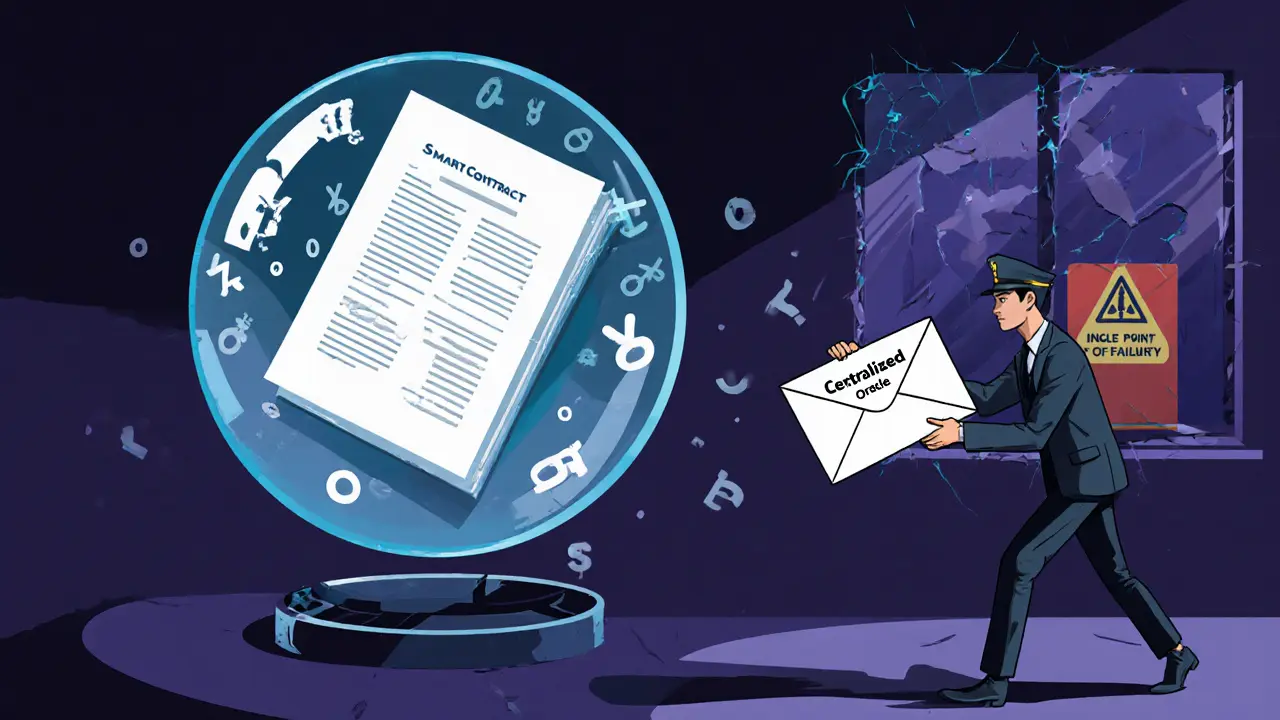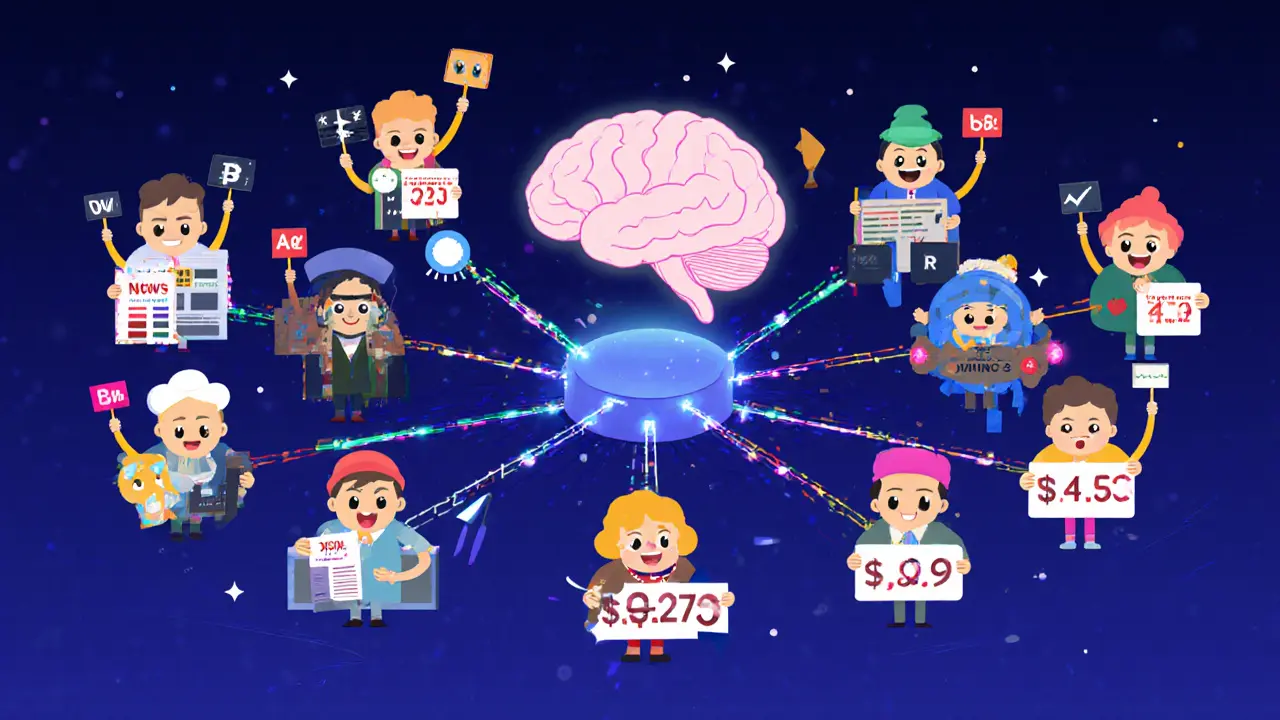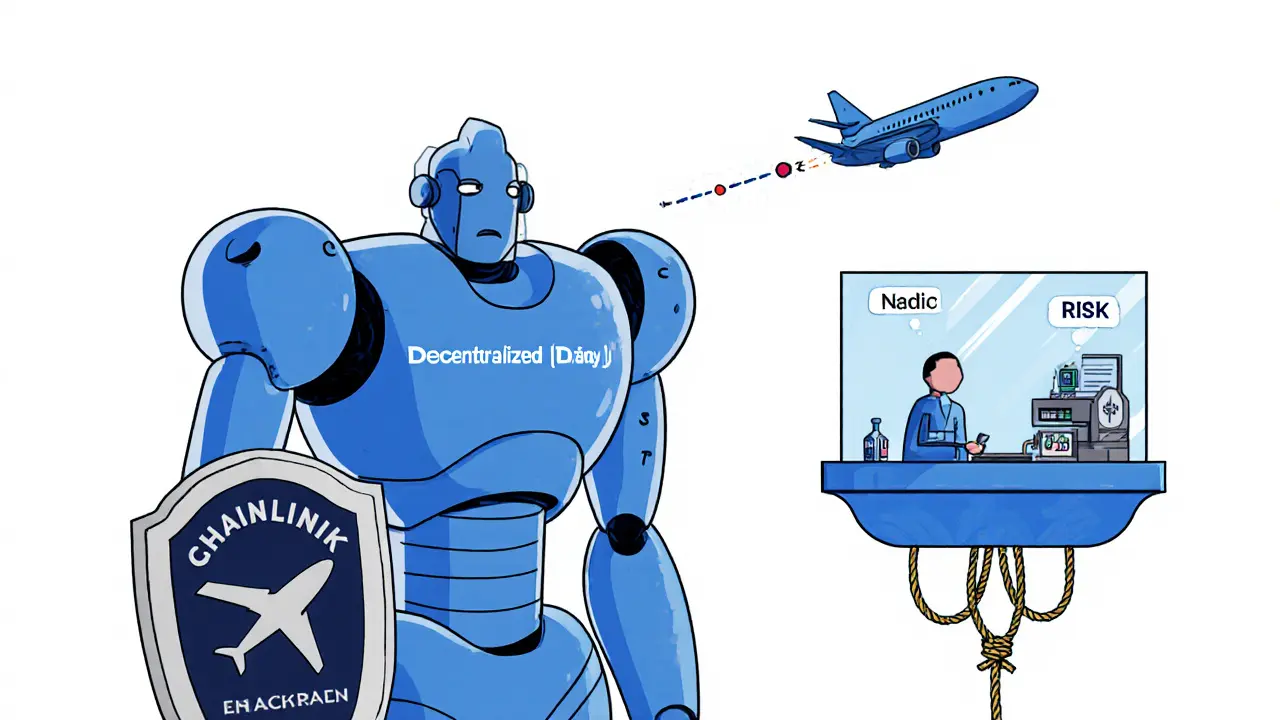
- 28 Oct 2025
- Elara Crowthorne
- 7
Oracle Risk Calculator
Assess Your Oracle Risk
Determine whether a centralized or decentralized oracle is appropriate for your smart contract based on your specific use case.
Imagine a smart contract that pays out insurance money when a hurricane hits. It sounds simple-until you realize the blockchain has no way of knowing if a hurricane actually happened. That’s where oracles come in. They’re the bridge between the blockchain and the real world. But not all oracles are built the same. Some rely on a single source. Others use dozens. And the difference between them can mean the difference between your money being safe-or gone forever.
What Exactly Is an Oracle?
An oracle is a service that feeds real-world data into a blockchain. Without it, smart contracts are stuck in a bubble. They can’t check stock prices, weather reports, sports scores, or even the current time. They only know what’s already on-chain. So if you want a DeFi loan to auto-repay when Bitcoin hits $60,000, you need an oracle to tell the contract what Bitcoin’s price is right now.
Oracles aren’t just nice-to-have-they’re essential. As of 2024, over $50 billion in assets across DeFi protocols depend on oracles to function. If the oracle fails, the contract fails. And when that happens, users lose money. That’s why the design of the oracle matters more than most people realize.
Centralized Oracles: Simple, But Risky
A centralized oracle is run by one company or team. Think of it like a single person delivering mail to your house. If they’re reliable, great. If they’re late, corrupt, or just go offline, you’re stuck.
These oracles are easy to set up. Developers integrate them quickly because there’s no complex consensus to manage. One API call, one data source, one point of failure. That’s why early blockchain apps used them. They were fast, cheap, and simple.
But here’s the problem: blockchains are designed to remove trust. Centralized oracles bring it right back. If the company running the oracle gets hacked, makes a mistake, or decides to manipulate data, every smart contract relying on it is compromised. And because blockchain transactions are irreversible, there’s no undo button.
Chainlink calls this the "garbage in, garbage out" problem. If the oracle feeds a fake price into a lending protocol, users might get liquidated for no reason. Their funds vanish. And no one can prove it was the oracle’s fault after the fact.
Some projects still use centralized oracles-for non-critical tasks like displaying the current temperature in a game. But for anything involving money, it’s a gamble no one should take.
Decentralized Oracles: Built to Resist Failure
A decentralized oracle doesn’t rely on one source. It pulls data from multiple independent providers-weather stations, financial exchanges, news sites-and then checks them against each other.
For example, if a smart contract needs to know the price of Ethereum, a decentralized oracle might ask 15 different data feeds: Coinbase, Binance, Kraken, Bitstamp, and others. It ignores outliers, averages the rest, and only then sends the result on-chain.
This is where consensus comes in. Most decentralized oracles use Byzantine Fault Tolerance (BFT) algorithms. That means even if 3 out of 15 nodes lie or go offline, the system still works. The network ignores the bad data and trusts the majority.
Chainlink, the most widely used decentralized oracle network, goes even further. It layers decentralization across three levels: data sources, node operators, and the network itself. That means even if one data provider is compromised, and one node operator is corrupt, the system still holds up.
Decentralized oracles don’t just prevent fraud-they prevent accidents. A server crash? One node fails. A DDoS attack? Other nodes keep running. A developer makes a typo in the code? The data is cross-verified before being accepted.
That’s why over 90% of top DeFi protocols-like Aave, Compound, and Synthetix-use decentralized oracles. They’re not just safer. They’re the only way to maintain the trustless nature of blockchain.

Performance Trade-Offs: Speed vs Security
Decentralized oracles aren’t perfect. They’re slower. And they cost more.
Why? Because every piece of data has to be collected, verified, and agreed upon by multiple parties. That takes time. A centralized oracle might update a price in 50 milliseconds. A decentralized one might take 500 milliseconds. In high-frequency trading, that delay matters.
That’s where Pyth Network comes in. It’s designed for speed. Instead of waiting for consensus, it uses financial institutions-like hedge funds and exchanges-as data providers. These entities have a financial incentive to report accurate data quickly. The result? Near real-time price feeds with strong security.
But even Pyth isn’t as fast as a single centralized API. And it’s not cheaper. Running multiple nodes, paying data providers, and maintaining consensus requires more infrastructure. That’s why decentralized oracles charge fees-often paid in LINK or other tokens.
Centralized oracles? Free or nearly free. But you’re paying in risk, not money.
Push vs Pull: How Data Gets to the Chain
There’s another layer to this: how data is delivered.
Push oracles send data automatically-every few seconds, every minute, or when a trigger happens. This keeps information fresh. But it’s wasteful. If no one asks for the data, the network still uses bandwidth and computing power to send it.
Pull oracles wait for a request. A smart contract says: "Give me the ETH/USD price." Then the oracle fetches it. This saves resources. But if the contract needs data right now, and the oracle is busy, you get a delay.
Chainlink uses both. It pushes key prices (like BTC and ETH) continuously, and pulls less common data on demand. That balance gives it flexibility without sacrificing reliability.
Centralized oracles almost always use push models. It’s simpler. But if the push fails, you’re left with stale data. And stale data in a DeFi contract can trigger liquidations, swaps, or losses.

Who’s Leading the Market?
Chainlink dominates. It’s the de facto standard. It powers over 80% of major DeFi protocols. Its network is live on Ethereum, Solana, Polygon, and dozens of other chains. It’s battle-tested.
Pyth Network is the main challenger. It’s faster, optimized for financial data, and backed by major trading firms. It’s gaining traction in high-speed DeFi apps.
Other players like Band Protocol and API3 exist, but they’re smaller. They’re useful for niche use cases, but not yet trusted for billion-dollar contracts.
Enterprise adoption is growing too. Banks and insurance companies are testing decentralized oracles for real-world asset tokenization. Why? Because regulators care about transparency. Decentralized oracles can prove where data came from. Centralized ones can’t.
When Should You Use Which?
Here’s the simple rule:
- Use centralized oracles only if you’re building something non-financial, low-value, or experimental. Think: a game that shows the weather, or a voting system that doesn’t handle real money.
- Use decentralized oracles for anything involving money, assets, or irreversible outcomes. Loans, insurance, derivatives, staking rewards, automated payments-any of these need decentralization.
There’s no middle ground. If your contract moves value, you need decentralized data. Period.
Even if you think "my app isn’t important," someone else might build on top of it. A small flaw in your oracle can cascade into a system-wide failure. That’s why top developers don’t cut corners here.
The Future: Hybrid Smart Contracts
The next evolution isn’t just about oracles-it’s about how they’re used. Enter hybrid smart contracts.
These combine on-chain logic with off-chain computation. For example: a contract might use a decentralized oracle to confirm a flight delay, then trigger an insurance payout. But the payout calculation? That happens off-chain, in a secure environment, before being verified on-chain.
Chainlink calls this "oracle-powered smart contracts." It’s the future. Real-world contracts-like supply chain agreements, rental leases, or legal settlements-will rely on this model.
But the foundation? Still the oracle. And for that, decentralization isn’t optional. It’s the only way to ensure the system stays trustless, secure, and fair.
Can a centralized oracle be made secure?
No. Even with audits, encryption, or multi-signature controls, a centralized oracle remains a single point of failure. If the operator is compromised, hacked, or coerced, all data becomes untrustworthy. Blockchains exist to remove trust in intermediaries. A centralized oracle reintroduces that risk. That’s why no major DeFi protocol uses one for critical functions.
Are decentralized oracles always slower?
Usually, yes-but not always. Modern networks like Pyth use financial institutions as data providers, reducing latency significantly. Some decentralized oracles can deliver data in under 100 milliseconds. Still, they’re slower than a direct API call. The trade-off is security: you gain reliability at the cost of speed. For most applications, that’s worth it.
How do I know if a project uses a decentralized oracle?
Check the project’s documentation or technical whitepaper. Look for mentions of Chainlink, Pyth Network, or "multi-source data verification." If it just says "API" or "data feed from [company]," it’s likely centralized. Also, look at the blockchain explorer-decentralized oracles often show multiple transaction inputs from different nodes.
Can decentralized oracles be hacked?
They’re much harder to hack. But not impossible. If a majority of nodes are controlled by one entity, or if all data sources are manipulated at once (like all weather stations reporting fake data), the system can be fooled. That’s why the best oracles use diverse, independent sources-geographically and organizationally spread out. Chainlink’s multi-layered design makes this extremely difficult.
Do I need to pay to use a decentralized oracle?
Yes. Most decentralized oracles charge a fee, paid in tokens like LINK or PYTH. This pays node operators and data providers. For most users, the cost is tiny-often less than a dollar per transaction. But for high-frequency applications, it adds up. That’s why some protocols bundle oracle fees into their own tokenomics.
Is Chainlink the only good option?
No. Pyth Network is a strong alternative, especially for low-latency financial data. Band Protocol and API3 serve niche use cases. But Chainlink has the largest network, most integrations, and longest track record. For most developers, it’s the safest starting point.

7 Comments
Centralized oracles are a joke. One company controlling your insurance payout? That’s not blockchain, that’s just a bank with a fancy logo. If your smart contract can’t survive a single point of failure, you shouldn’t be touching DeFi at all. Chainlink isn’t perfect, but at least it doesn’t rely on some dude in a cubicle to type in a number.
💯 Exactly. Decentralized oracles = peace of mind. Centralized = panic mode.
Guys i just wanna say i used a centralized oracle for my pet project and it worked fine lol. why do we need all this complexity? its just a weather app for cats 🐱
While it is true that centralized oracles introduce unacceptable risk for financial applications, it is also important to acknowledge that decentralization introduces latency, cost, and operational overhead-factors that are not trivial for emerging protocols with limited capital. The notion that decentralization is an absolute requirement, rather than a risk-mitigation strategy, reflects a dogmatic misunderstanding of engineering trade-offs.
You’re all missing the point. Decentralized oracles are just a new form of centralization-look at Chainlink. Who runs the nodes? Big crypto firms. Who pays them? Token holders. Who audits them? The same VC-funded labs that built them. It’s a closed loop. The real power is still in the hands of a few. The blockchain is supposed to be open, but now we’ve got oracle oligarchies pretending to be decentralized. Pyth? Same thing. Hedge funds are just Wall Street in hoodies. You think they’re giving you accurate data because they care? They’re giving it to you because they’re making money off the trades. This isn’t trustless-it’s just trust shifted to a different set of elites.
And don’t even get me started on the fees. You pay in LINK, but LINK is controlled by the same people who run the oracle nodes. It’s a circular economy built on gaslighting. Real decentralization would mean open-source, permissionless, incentivized data providers from every corner of the globe-not just NY hedge funds and San Francisco dev shops. The fact that you all cheer for Chainlink like it’s a hero? That’s the problem.
And yes, I’ve read the whitepapers. I’ve analyzed the node distributions. I’ve traced the token flows. This isn’t innovation. It’s rebranding.
True decentralization would let anyone submit data, anyone verify it, and anyone challenge it without paying a fee or holding a token. We’re not there. We’re not even close. And pretending we are is the real danger.
What if the entire decentralized oracle network is compromised at once? What if all the data sources are fed fake data by a single entity controlling the global financial infrastructure? You think they don’t have the power to manipulate 15 feeds? They already control the stock markets, the news, the weather satellites. Why would oracles be any different? This is all a distraction. The real power isn’t on the blockchain-it’s in the servers behind the APIs. You’re just moving the scam from one vault to another.
For anyone building on-chain insurance contracts, don’t just pick Chainlink because it’s popular. Check the data source diversity. Are they using NOAA, weather underground, and private stations? Or just one commercial feed? I’ve seen projects that call themselves 'decentralized' but pull 12/15 feeds from the same parent company. That’s not decentralization-that’s window dressing. Always audit the data lineage, not just the node count.